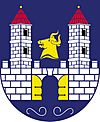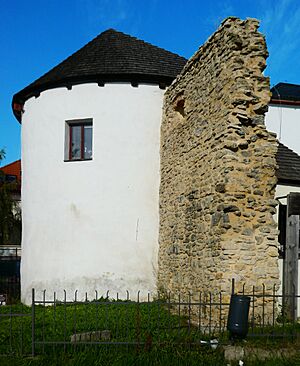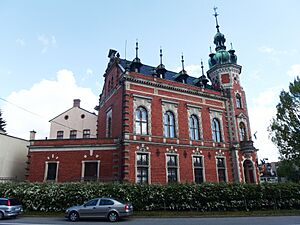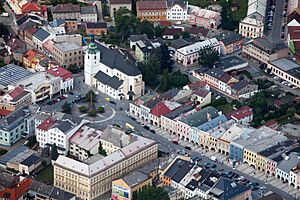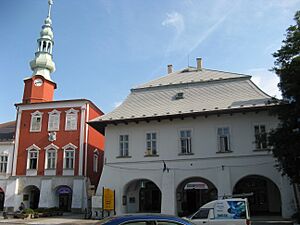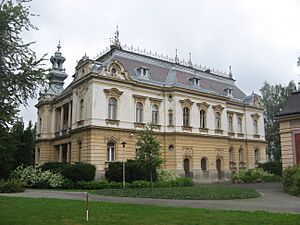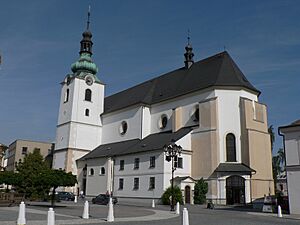Svitavy facts for kids
Quick facts for kids
Svitavy
|
|||
|---|---|---|---|
|
Town
|
|||
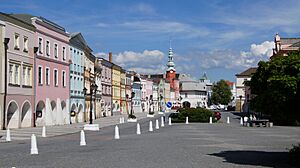
Míru Square
|
|||
|
|||
| Country | |||
| Region | Pardubice | ||
| District | Svitavy | ||
| First mentioned | 1256 | ||
| Area | |||
| • Total | 31.33 km2 (12.10 sq mi) | ||
| Elevation | 435 m (1,427 ft) | ||
| Population
(2024-01-01)
|
|||
| • Total | 16,108 | ||
| • Density | 514.14/km2 (1,331.62/sq mi) | ||
| Time zone | UTC+1 (CET) | ||
| • Summer (DST) | UTC+2 (CEST) | ||
| Postal code |
568 02
|
||
Svitavy (pronounced SVEE-tah-vee) is a town in the Pardubice Region of the Czech Republic. It is home to about 16,000 people. Svitavy is famous as the birthplace of Oskar Schindler. He was a German businessman who saved many Jewish people during World War II. The town is also a center for the Esperanto language movement in the Czech Republic. Svitavy has a beautiful old town center. It is protected by law as an important historical area.
Contents
Town Parts and Names
What are the parts of Svitavy?
Svitavy is made up of four main parts. These are Lačnov, Lány, Město, and Předměstí.
Where did the name Svitavy come from?
The town of Svitavy gets its name from the Svitava River. The river's name comes from an old Czech word, svítat. This word meant "to be clear." It described the river's clear water.
Geography of Svitavy
Where is Svitavy located?
Svitavy is located in the Svitavy Uplands. It is about 57 kilometers (35 miles) southeast of Pardubice. It is also about 60 kilometers (37 miles) north of Brno. The highest point in the town is 475 meters (1,558 feet) above sea level.
What rivers and ponds are in Svitavy?
The Svitava River starts in Svitavy and flows through the town. There are two important fish ponds near the town. These are called Svitavský and Rosnička. They are what is left of eleven old water areas around the town. Rosnička Pond was created in the early 1500s. Svitavský Pond was made in 1953. Besides raising fish, these ponds are popular places for people to relax and have fun.
History of Svitavy
How was Svitavy founded?
Svitavy was first settled around 1150 by monks. They came from a place called Litomyšl. They built the Church of Saint Giles. They also started a small settlement called Stará Svitava near an old trade route.
Around 1250, more settlers arrived. Most of them spoke German. They started a new settlement called Nová Svitava. Svitavy was first officially mentioned in 1256. This was when the bishop of Olomouc took control of the town. This year is seen as the official founding year of Svitavy.
What happened in Svitavy's early history?
In 1389, town walls were built to protect Svitavy. These walls helped during the Hussite Wars, but the town was still captured. Svitavy changed owners many times. In the 1500s, the town's economy grew strong.
However, the Thirty Years' War stopped this growth. In 1645, the town was looted. A big fire in 1781 destroyed most of Svitavy. The town also suffered when armies marched through it during the Napoleonic and Austro-Prussian wars.
How did Svitavy grow in the 1800s?
In 1849, a railway was built in Svitavy. This helped the town grow a lot. The textile industry became very important. More than one hundred textile factories were built. Svitavy is still an industrial town today, though the types of industries have changed.
What happened during World War II?
Historically, Svitavy was a German-speaking town. There was also a smaller group of Czech-speaking people. In the early 1900s, there were some disagreements between these groups.
In October 1938, Nazi Germany took control of Svitavy. It became part of a region called Reichsgau Sudetenland. After World War II ended in 1945, the German population was asked to leave. New people from all over Czechoslovakia moved into Svitavy.
Population of Svitavy
How many people live in Svitavy?
Svitavy has a population of about 16,000 people. The number of people living in the town has changed over time. For example, in 1869, there were about 8,670 people. By 1910, the population grew to almost 15,000. After World War II, the population dropped but then started to grow again.
Economy of Svitavy
What kind of businesses are in Svitavy?
Svitavy does not have very large companies. Instead, it has many medium-sized businesses. The biggest employers in Svitavy make industrial textiles and cardboard packaging. These companies include Fibertex Nonwovens and Westrock Packaging Systems Svitavy.
Transport in Svitavy
How do people travel to and from Svitavy?
Svitavy is an important place for travel in its area. It has good train connections to other parts of the Czech Republic. The main train line between Prague and Brno goes through Svitavy. There is also a local train line.
The town has a bus station with buses going to many places. Two main roads also cross just north of Svitavy. These roads connect the town to cities like Brno and Olomouc.
Culture in Svitavy
What is the Esperanto movement in Svitavy?
The Czech Esperanto Association is based in Svitavy. Esperanto is a language created to be easy for people from different countries to learn. The association organizes meetings and events. It also runs the Esperanto Museum in Svitavy.
What other cultural events and places are in Svitavy?
Since 2011, Svitavy has hosted an annual music festival called Rosnička.
The Town Museum and Gallery opened in 1894. It has exhibits about the history of washing technology. It also has an exhibition about Oskar Schindler, who was born in Svitavy.
The Fabrika cultural center is a modern space. It used to be a textile factory. Now it has a theater and a library.
Sport in Svitavy
What sports teams are in Svitavy?
Svitavy is known for its basketball team, Tuři Svitavy. They used to play in the top Czech league.
The Svitavský stadion is a stadium for football and athletics. The local football team is TJ Svitavy.
What about motorcycle speedway?
Motorcycle speedway races are held in Svitavy. The Areál Chihelna Svitavy stadium has hosted important races in the past. It still holds qualifying races for events today.
Sights to See in Svitavy
What is special about Svitavy's town center?
Svitavy has a beautiful and historic town center. Its main square is almost 500 meters (1,640 feet) long. This makes it one of the longest squares in the Czech Republic. Many old buildings with interesting designs line the square. The square also has the second longest arcade (a covered walkway with arches) in the country. Many Renaissance houses from the 1500s were rebuilt in the Baroque style after a fire in 1781.
In the middle of the square is a Baroque Marian column from 1703. It has statues of three saints: St. Sebastian, St. Florian, and St. John of Nepomuk. There is also a statue of St. Rosalie. The Fountain of St. Florian from 1783 is also on the square.
The town walls, built in 1389, were mostly taken down in the 1800s. Only one semi-circular part of the wall remains.
Important Civic Buildings
- Old Town Hall: This building was originally from the Renaissance period. It was rebuilt after fires in 1781 and 1849. It was the town hall until 1933. Now, it is used for shops.
- "U Mouřenína" House: Next to the Old Town Hall is this old Renaissance house. It was built in 1554. Today, it has the tourist information center.
- Ottendorfer House: This red-brick building with a tower is a symbol of Svitavy. It was built in 1892 by Oswald Ottendorfer, who was born in Svitavy. It used to be a large German-language library. Now, it holds the Esperanto Museum and a tea room. The beautiful hall upstairs is used for concerts.
- Langer's Villa: This building is the current town hall. It was built in 1892 with fancy decorations. It belonged to a very rich family in Svitavy. The town bought it in 1933 to use as the town hall.
- Budig's Villa: This villa was built in 1892 for a former mayor and businessman, Johann Budig. Today, it houses the Town Museum and Gallery.
Important Church Buildings
- Church of the Visitation of the Virgin Mary: This church is on the main square. It was likely built around 1250. After a fire in 1781, it was rebuilt in the Baroque style. You can go up its tower for a great view.
- Church of Saint Giles: This church was originally built around 1150. It was rebuilt in the Baroque style in 1689. It still has its original inside decorations. The nearby Catholic parish house is also very old, rebuilt in the Baroque style in the 1600s.
- Church of Saint Joseph: This church was built between 1894 and 1896. It has beautiful decorations. Today, a hospital owns the building.
- Convent of the Sisters of Grace: This convent was founded in 1871. It used to be a hospital and now helps people in need. It includes the Neo-Gothic Chapel of Saint Vincent de Paul from 1874.
Notable People from Svitavy
Svitavy has been home to several important people:
- Hermann Edler von Zeissl (1817–1884), an Austrian skin doctor.
- Oswald Ottendorfer (1826–1900), a German-American journalist and helper of others.
- Oskar Schindler (1908–1974), a German businessman who saved many Jewish people during World War II.
- Heidi Lück (born 1943), a German politician.
- Jiří Pernes (born 1948), a historian.
- Jan Moravec (born 1987), a football player.
Sister Cities
Svitavy is twinned with these cities, meaning they have friendly relationships:
 Lądek-Zdrój, Poland
Lądek-Zdrój, Poland Perechyn, Ukraine
Perechyn, Ukraine Stendal, Germany
Stendal, Germany Strzelin, Poland
Strzelin, Poland Žiar nad Hronom, Slovakia
Žiar nad Hronom, Slovakia
See also
 In Spanish: Svitavy para niños
In Spanish: Svitavy para niños



